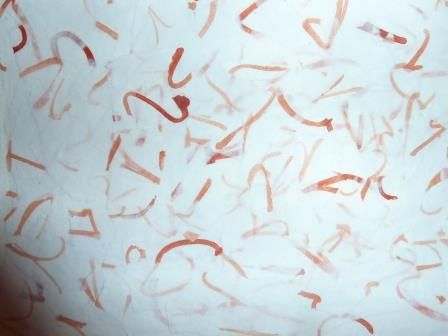I have spent time at the river and been given access to a particularly good spot through a private garden.
Laying them out to try and join marks is a struggle. They are not highly defined; they are subtle marks.
I now have a fair few stones, and while I don’t think they are enough, I know I need to work with what I’ve got, to see what they form before finding more.
I have gathered further 2 tone clay stones and laid them out. Still wet from the river the defination of the border lines between grey and pink clay isn’t so strong.
I am laying them out trying to join together elements of gesture found within each stone.
There are passages that catch my eye, but the marks don’t join up as I had hoped.
(Trouble uploading pics again – look on http://twitpic.com/dwm4eu and http://twitpic.com/dwm43m for images linked with this post)
I have had the good furtune to mention to a fellow student my interest in a type of rock and just as luck would have it he had an previous colleague who is a geologist. I have emailed him this evening and have already had a reply about the rust/grey rock.
Clay formed in the Devonian period as part of the “old red sandstone” when Britain was on the edge of giant desert. Formed in a shallow “playa” (an area of flat, dried-up land, especially a desert basin from which water evaporates quickly) lake formed when a flash flood washed down onto the desert plain.
I do enjoy a good back-story!
Writing and Stones
– how will my response be?
I have scratched into the softer siltstone grey and rust coloured (2 distinct colours) stones. (Trouble getting photo on here). On putting these in water, most of my marks disappear.
I have been stacking the stones, grouping them by rock type. Many of these I have written on in various ways. This brings to mind, cairns, especially to me a Peace Cairn in Ireland http://www.iol.ie/~mcmullin/cairn.htm
I am most interested in the grey and rust coloured stones. These are clay-like and I am trying to find out what exactly they are.
One of the things I have been considering is how to write with stones without making the marks myself. How can I find writing in the stones?
These grey/rust stones each provide a fragment of writing. What might happen if I joined the marks formed in the borders between the two colours. Would this be writing?
Wobudong – an exhibition of writing without meaning (http://w0budong.wordpress.com/)
I am working on this project – gestural writing on pebbles. I wrote in watercolour on a stone in Newlyn, Cornwall, where the tide would come in and wash it off. I’ve now been to my local river and collected stones and discovered that the layer of rock here (Abergavenny) is Lower Devonian Rocks & Alluvium (same types as where I was in Cornwall in August (see British Geological survey :https://www.bgs.ac.uk/data/mapViewers/home.html?src=topNav)).
I have a pinterest board here: http://www.pinterest.com/catherinewp/pebbles/ with images I am using to consider what I am doing in relation to some of what has come before.
I found, looking in Bertrand Russell’s ‘Wisdom of the West’ (p22) that “The Latin word ‘calculation’ means ‘a handling of pebbles’.”
I’ve written on the stones using a paintbrush and water and I was trying to see how many stones I could write on before the writing disappeared.
The presence and then absence of the writing interests me, just as the notion of the sea washing the watercolour off the stone in Newlyn.








